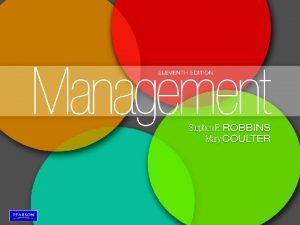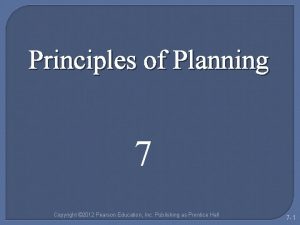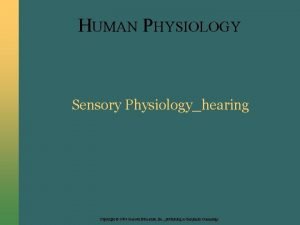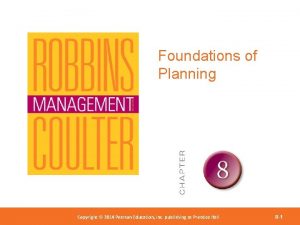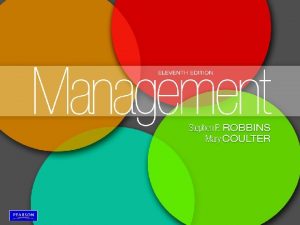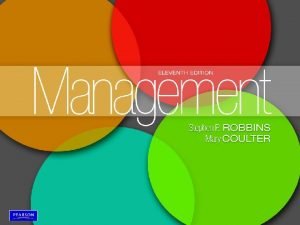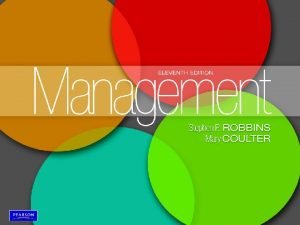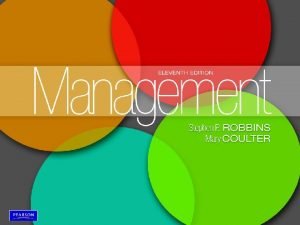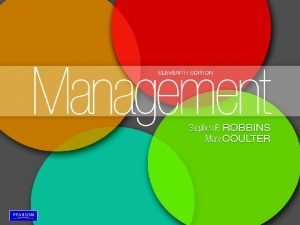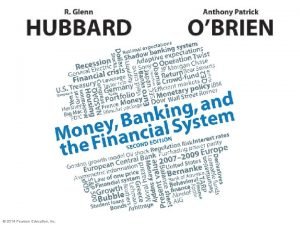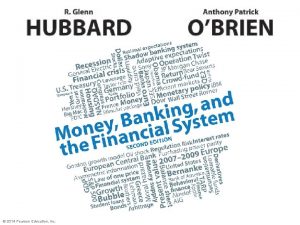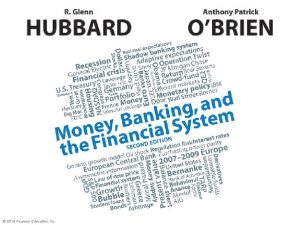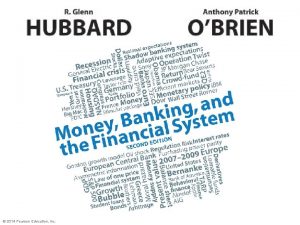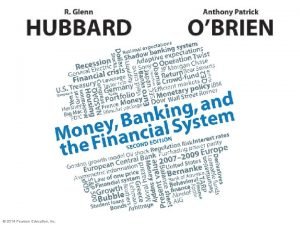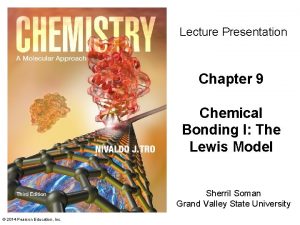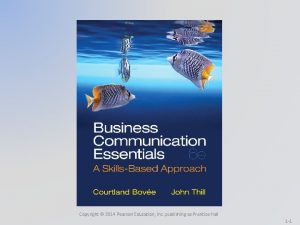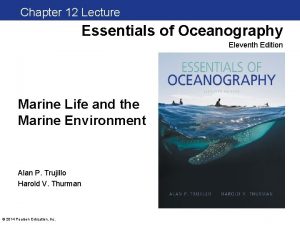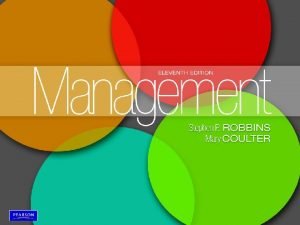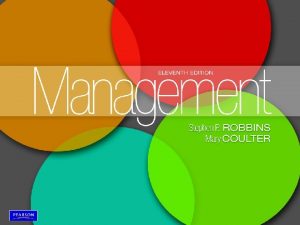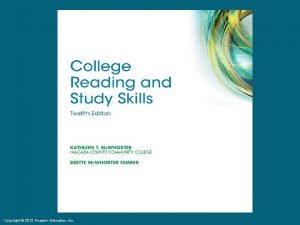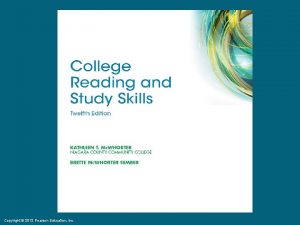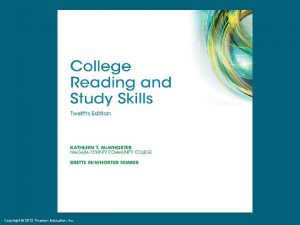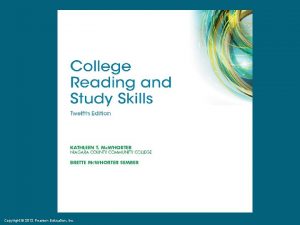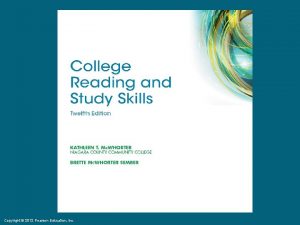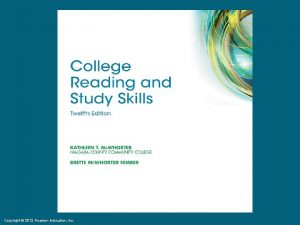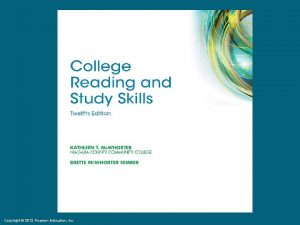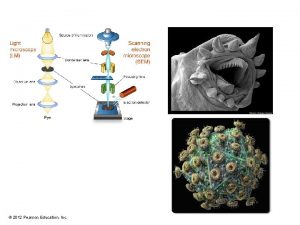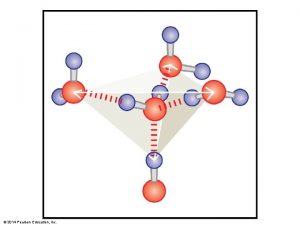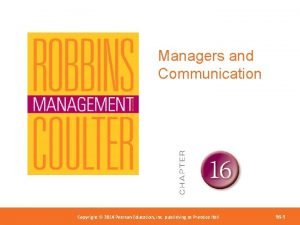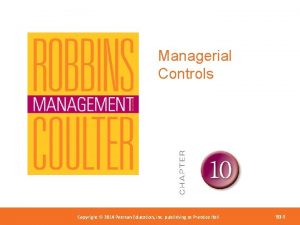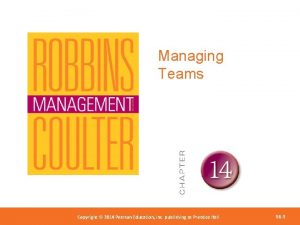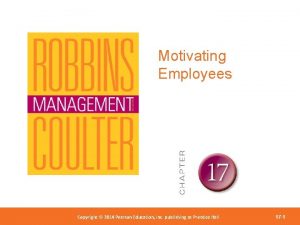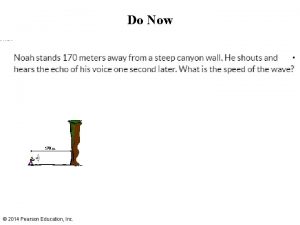Communication Copyright Pearson Education Copyright 2012 2014 Pearson











































- Slides: 43

Communication Copyright Pearson. Education, Copyright © © 2012 2014 Pearson Inc. Publishing as Prentice Hall 16 -1

Define the nature and function of communication. Compare and contrast methods of interpersonal communication. Identify barriers to effective interpersonal communication and how to overcome them. Explain how communication can flow most effectively in organizations. Describe how technology affects managerial communication and organizations. Discuss contemporary issues in communication. Copyright Education, Copyright©© 2012 2014 Pearson Education. Inc. Publishing as Prentice Hall 16 -2

What Is Communication? • Communication - the transfer and understanding of meaning. – Transfer means the message was received in a form that can be interpreted by the receiver. – Understanding the message is not the same as the receiver agreeing with the message. Copyright Pearson. Education, Copyright © © 2012 2014 Pearson Inc. Publishing as Prentice Hall 16 -3

What Is Communication? (cont. ) • Interpersonal Communication communication between two or more people. • Organizational Communication - all the patterns, networks, and systems of communications within an organization. Copyright Pearson. Education, Copyright © © 2012 2014 Pearson Inc. Publishing as Prentice Hall 16 -4

Functions of Communication • Control – Formal and informal communications act to control individuals’ behaviors in organizations. • Motivation – Communications clarify for employees what is to be done, how well they have done it, and what can be done to improve performance. Copyright Pearson. Education, Copyright © © 2012 2014 Pearson Inc. Publishing as Prentice Hall 16 -5

Functions of Communication (cont. ) • Emotional Expression – Social interaction in the form of work group communications provides a way for employees to express themselves. • Information – Individuals and work groups need information to make decisions or to do their work. Copyright Pearson. Education, Copyright © © 2012 2014 Pearson Inc. Publishing as Prentice Hall 16 -6

Methods of Interpersonal Communication • Message - a purpose to be conveyed. • Encoding - converting a message into symbols. • Channel - the medium a message travels along. • Decoding - retranslating a sender’s message. Copyright Pearson. Education, Copyright © © 2012 2014 Pearson Inc. Publishing as Prentice Hall 16 -7

Methods of Interpersonal Communication (cont. ) • Communication process - the seven elements involved in transferring meaning from one person to another. • Noise - any disturbances that interfere with the transmission, receipt, or feedback of a message. Copyright Pearson. Education, Copyright © © 2012 2014 Pearson Inc. Publishing as Prentice Hall 16 -8

Exhibit 16 -1 The Interpersonal Communication Process Copyright Pearson. Education, Copyright © © 2012 2014 Pearson Inc. Publishing as Prentice Hall 16 -9

Nonverbal Communication • Nonverbal communication transmitted without words. • Body language - gestures, facial configurations, and other body movements that convey meaning. • Verbal intonation - an emphasis given to words or phrases that conveys meaning. Copyright Pearson. Education, Copyright © © 2012 2014 Pearson Inc. Publishing as Prentice Hall 16 -10

Exhibit 16 -2 Comparison of Communication Methods Copyright Pearson. Education, Copyright © © 2012 2014 Pearson Inc. Publishing as Prentice Hall 16 -11

Exhibit 16 -2 Comparison of Communication Methods (cont. ) Copyright Pearson. Education, Copyright © © 2012 2014 Pearson Inc. Publishing as Prentice Hall 16 -12

Exhibit 16 -2 Comparison of Communication Methods (cont. ) Copyright Pearson. Education, Copyright © © 2012 2014 Pearson Inc. Publishing as Prentice Hall 16 -13

Exhibit 16 -2 Comparison of Communication Methods (cont. ) Copyright Pearson. Education, Copyright © © 2012 2014 Pearson Inc. Publishing as Prentice Hall 16 -14

Barriers to Communication • Filtering - the deliberate manipulation of information to make it appear more favorable to the receiver. • Information overload - occurs when information exceeds our processing capacity. • Jargon - specialized terminology or technical language that members of a group use to communicate among themselves. Copyright Pearson. Education, Copyright © © 2012 2014 Pearson Inc. Publishing as Prentice Hall 16 -15

Overcoming the Barriers • Use Feedback - ask questions about a message to determine whether it was received and understood as intended • Simplify Language – consider the audience to whom the message is directed and tailor the language to them Copyright Pearson. Education, Copyright © © 2012 2014 Pearson Inc. Publishing as Prentice Hall 16 -16

Overcoming the Barriers (cont. ) • Active listening - listening for full meaning without making premature judgments or interpretations. Copyright Pearson. Education, Copyright © © 2012 2014 Pearson Inc. Publishing as Prentice Hall 16 -17

Exhibit 16 -3 Active Listening Behaviors Copyright Pearson. Education, Copyright © © 2012 2014 Pearson Inc. Publishing as Prentice Hall 16 -18

Formal Versus Informal Communication • Formal communication - communication that takes place within prescribed organizational work arrangements. • Informal communication that is not defined by the organization’s structural hierarchy. Copyright Pearson. Education, Copyright © © 2012 2014 Pearson Inc. Publishing as Prentice Hall 16 -19

Direction of Communication • Town hall meeting - informal public meetings where information can be relayed, issues can be discussed, or just is a way to bring employees together to celebrate accomplishments • Downward communication that flows downward from a manager to employees Copyright Pearson. Education, Copyright © © 2012 2014 Pearson Inc. Publishing as Prentice Hall 16 -20

Direction of Communication (cont. ) • Upward communication - communication that flows upward from employees to managers. • Lateral communication - communication that takes place among any employees on the same organizational level. • Diagonal communication that cuts across work areas and organizational levels. Copyright Pearson. Education, Copyright © © 2012 2014 Pearson Inc. Publishing as Prentice Hall 16 -21

Organizational Communication Networks • Communication Networks - the variety of patterns of vertical and horizontal flows of organizational communication. • Grapevine - the informal organizational communication network. Copyright Pearson. Education, Copyright © © 2012 2014 Pearson Inc. Publishing as Prentice Hall 16 -22

Exhibit 16 -4 Organizational Communication Networks Copyright Pearson. Education, Copyright © © 2012 2014 Pearson Inc. Publishing as Prentice Hall 16 -23

Workplace Design and Communication • Open workplaces with few physical barriers and enclosures. Copyright Pearson. Education, Copyright © © 2012 2014 Pearson Inc. Publishing as Prentice Hall 16 -24

How Technology Affects Managerial Communication • Networked Systems - in a networked system, an organization’s computers are linked. Organizational members can communicate with each other and tap into information whether they’re down the hall, across town, or halfway across the world • Wireless Capabilities - wireless communication technology has the ability to improve work for managers and employees Copyright Pearson. Education, Copyright © © 2012 2014 Pearson Inc. Publishing as Prentice Hall 16 -25

Current Communication Issues • Managing Communication in an Internet World – Legal and security issues • Inappropriate use of company e-mail and instant messaging • Loss of confidential and proprietary information due to inadvertent or deliberate dissemination or to hackers – Lack of personal interaction • Being connected is not the same as face-to-face contact • Difficulties occur in achieving understanding and collaboration in virtual environments Copyright Pearson. Education, Copyright © © 2012 2014 Pearson Inc. Publishing as Prentice Hall 16 -26

Communication and Customer Service • Communicating Effectively with Customers – Recognize three components of the customer service delivery process: • The customer • The service organization • The service provider – Develop a strong service culture focused on the personalization of service to each customer. • Listen and respond to the customer. • Provide access to needed service information. Copyright Pearson. Education, Copyright © © 2012 2014 Pearson Inc. Publishing as Prentice Hall 16 -27

Getting Employee Input • In today’s challenging environment, companies need to get input from their employees • Suggestion Boxes - managers do business in a world today where you can’t afford to ignore such potentially valuable information Copyright Pearson. Education, Copyright © © 2012 2014 Pearson Inc. Publishing as Prentice Hall 16 -28

Exhibit 16 -5 How to Let Employees Know Their Input Matters Copyright Pearson. Education, Copyright © © 2012 2014 Pearson Inc. Publishing as Prentice Hall 16 -29

Communicating Ethically • Ethical communication - communication that includes all relevant information, is true in every sense, and is not deceptive in any way. Copyright Pearson. Education, Copyright © © 2012 2014 Pearson Inc. Publishing as Prentice Hall 16 -30

Review Learning Outcome 16. 1 • Define the nature and function of communication. – Communication is the transfer and understanding of meaning. – Interpersonal communication is communication between two or more people. – Organizational communication includes all the patterns, networks, and systems of communication within an organization. Copyright Pearson. Education, Copyright © © 2012 2014 Pearson Inc. Publishing as Prentice Hall 16 -31

Review Learning Outcome 16. 1 (cont. ) • The functions of communication include controlling employee behavior, motivating employees, providing a release for emotional expression of feelings and fulfillment of social needs, and providing information. Copyright Pearson. Education, Copyright © © 2012 2014 Pearson Inc. Publishing as Prentice Hall 16 -32

Review Learning Outcome 16. 2 • Compare and contrast methods of interpersonal communication. – The communication process contains even elements. • First, a sender has a message. • A message is a purpose to be conveyed. • Encoding converts a message into symbols. • A channel is the medium a message travels along. • Decoding happens when the receiver retranslates a sender’s message. • Finally, feedback occurs. Copyright Pearson. Education, Copyright © © 2012 2014 Pearson Inc. Publishing as Prentice Hall 16 -33

Review Learning Outcome 16. 2 (cont. ) • Managers can evaluate the various communication methods according to their feedback, complexity capacity, breadth potential, confidentiality, encoding ease, decoding ease, time-space constraint, cost, interpersonal warmth, formality, scanability, and time of consumption. Copyright Pearson. Education, Copyright © © 2012 2014 Pearson Inc. Publishing as Prentice Hall 16 -34

Review Learning Outcome 16. 2 (cont. ) • The communication methods include faceto-face, telephone, group meetings, formal presentations, memos, traditional mail, ax, employee publications, bulletin boards, other company publications, audio- and videotapes, hotlines, e-mail, computer conferencing, voice mail, teleconferences, and videoconferences. Copyright Pearson. Education, Copyright © © 2012 2014 Pearson Inc. Publishing as Prentice Hall 16 -35

Review Learning Outcome 16. 3 • Identify barriers to effective interpersonal communication and how to overcome them. – Barriers to effective communication include filtering, emotions, information overload, defensiveness, language, and national culture. – Managers can overcome these barriers by using feedback, simplifying language, listening actively, constraining emotions, and watching for nonverbal clues. Copyright Pearson. Education, Copyright © © 2012 2014 Pearson Inc. Publishing as Prentice Hall 16 -36

Review Learning Outcome 16. 4 • Explain how communication can flow most effectively in organizations. – Formal communication is communication that takes place within prescribed organizational work arrangements. – Informal communication is not defined by the organization’s structural hierarchy. – Communication in an organization can flow downward, upward, laterally, and diagonally. Copyright Pearson. Education, Copyright © © 2012 2014 Pearson Inc. Publishing as Prentice Hall 16 -37

Review Learning Outcome 16. 4 (cont. ) • The three communication networks include: – the chain, in which communication flows according to the formal chain of command – the wheel, in which communication flows between a clearly identifiable and strong leader and others in a work team – the all-channel, in which communication flows freely among all members of a work team. Copyright Pearson. Education, Copyright © © 2012 2014 Pearson Inc. Publishing as Prentice Hall 16 -38

Review Learning Outcome 16. 4 (cont. ) • Managers should manage the grapevine as an important information network. • The negative consequences of rumors can be minimized by communicating openly, fully, and honestly with employees. • Workplace design also influences organizational communication. That design should support four types of employee work: focused work, collaboration, learning, and socialization Copyright Pearson. Education, Copyright © © 2012 2014 Pearson Inc. Publishing as Prentice Hall 16 -39

Review Learning Outcome 16. 5 • Describe how technology affects managerial communication and organizations. – Technology: • improves a manager’s ability to monitor performance • gives employees more complete information to make faster decisions • has provided employees more opportunities to collaborate and share information; and it has made it possible for people to be fully accessible, anytime anywhere. Copyright Pearson. Education, Copyright © © 2012 2014 Pearson Inc. Publishing as Prentice Hall 16 -40

Review Learning Outcome 16. 6 • Discuss contemporary issues in communication. – The two main challenges of managing communication in an Internet world are the legal and security issues and the lack of personal interaction. – Organizations can manage knowledge by making it easy for employees to communicate and share their knowledge. Copyright Pearson. Education, Copyright © © 2012 2014 Pearson Inc. Publishing as Prentice Hall 16 -41

Review Learning Outcome 16. 6 (cont. ) • Communicating with customers is an important managerial issue because it can significantly affect a customer’s satisfaction with the service and the likelihood of being a repeat customer. • It’s important for organizations to get input from their employees. • Finally, a company’s communication efforts need to be ethical. Copyright Pearson. Education, Copyright © © 2012 2014 Pearson Inc. Publishing as Prentice Hall 16 -42

Copyright Education, Copyright©© 2012 2014 Pearson Education. Inc. Publishing as Prentice Hall 16 -43
 2014 pearson education inc
2014 pearson education inc 2012 pearson education inc
2012 pearson education inc 2012 pearson education inc
2012 pearson education inc Pearson education 2012
Pearson education 2012 2012 pearson education inc
2012 pearson education inc 2012 pearson education inc anatomy and physiology
2012 pearson education inc anatomy and physiology Pearson education inc. 2012
Pearson education inc. 2012 Pearson education inc. 2012
Pearson education inc. 2012 2012 pearson education inc anatomy and physiology
2012 pearson education inc anatomy and physiology Pearson mbo
Pearson mbo 2012 pearson education inc
2012 pearson education inc 2012 pearson education inc
2012 pearson education inc 2012 pearson education inc
2012 pearson education inc Pearson education 2012
Pearson education 2012 Pearson education inc. 2012
Pearson education inc. 2012 2012 pearson education inc
2012 pearson education inc 2012 pearson education inc
2012 pearson education inc 2012 pearson education inc
2012 pearson education inc Pearson 2012
Pearson 2012 2012 pearson education inc
2012 pearson education inc 2014 pearson education inc
2014 pearson education inc 2014 pearson education inc
2014 pearson education inc 2014 pearson education inc
2014 pearson education inc 2014 pearson education inc
2014 pearson education inc 2014 pearson education inc
2014 pearson education inc 2014 pearson education inc
2014 pearson education inc 2014 pearson education inc
2014 pearson education inc 2014 pearson education inc
2014 pearson education inc 2014 pearson education inc
2014 pearson education inc 2014 pearson education inc
2014 pearson education inc 2014 pearson education inc
2014 pearson education inc 2014 pearson education inc
2014 pearson education inc Pearson education
Pearson education 2014 pearson education inc
2014 pearson education inc 2014 pearson education inc
2014 pearson education inc 2014 pearson education inc
2014 pearson education inc 2014 pearson education inc
2014 pearson education inc 2014 pearson education inc
2014 pearson education inc Marine species
Marine species 2014 pearson education inc
2014 pearson education inc 2014 pearson education inc
2014 pearson education inc 2014 pearson education inc
2014 pearson education inc 2014 pearson education inc
2014 pearson education inc 2014 pearson education inc
2014 pearson education inc




